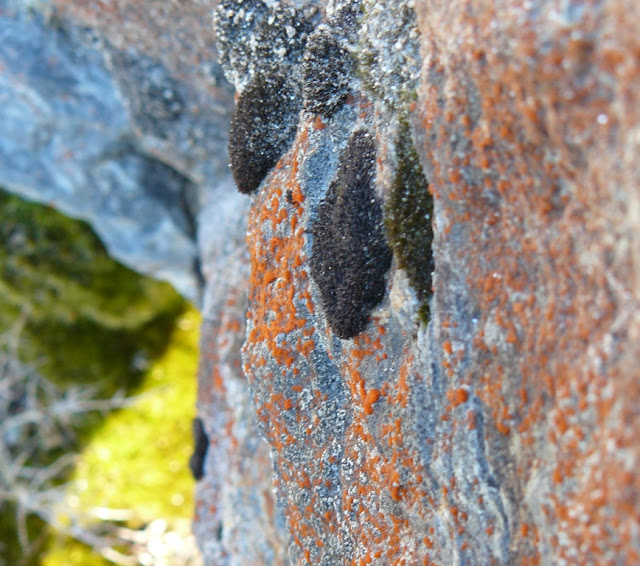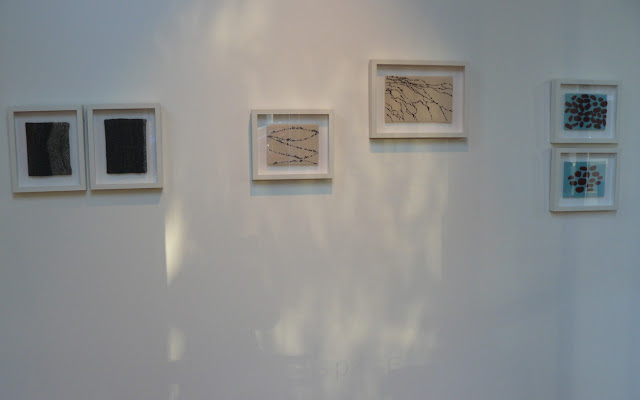 |
| BEFORE: Stockton Plateau, looking towards Happy Valley aka Cyprus Extension, not yet open cut but riddled with undergound mine shafts) See all the blue tarns? The sandstone is a waterproof seal and the rainfall 6m p/a so most of the water just sits on the surface in big puddles making a unique ecosystem. |
Ever since I found out that Solid Energy sponsors (almost free) tours of its open cut coal mine at Stockton I've wanted to go visit. Yes, there are plenty of coal mines (at Huntly) close to where I live but they don't offer 5-6 hour guided tours with an ex-miner-guide mostly paid for by the company! Mines are such dangerous (not to mention controversial) places (like this local one closed today due to methane build up) and very few allow the public inside. I spend way too much time searching the internet looking for mine tours, so I know this for sure.
 |
| DURING: An open cut mine is visually confusing because its really just a big mucky mess in a constant state of flux. |
So I schemed and planned and persuaded my buddy Robin (who has visited Stockton before for her work and is the friend most tolerant of my current mine obsession) to take me there last week. The reason I really really wanted to see a mine with my own eyes is evident in these photos I took on the tour. Photographs of mines are really difficult to make sense of (I've made these ones as big as I can to help you). The enormous scale, muddy colours and dusty atmosphere combine to make it very difficult to tell what is up or down, vertical or horizontal; just the kind of information I need to interpret or represent a mine in textile relief. I hoped that the tour would give me, literally, a fresh insight into mining topography.
 |
AFTER: These stripes are the kind of repetitive pattern I was looking for.
Just to give you a sense of scale, the little square thing in the middle of the image is the top of the cab of a really big truck.
The greenish terraces at the top of the image have been revegetated. The greyish ones in the middle are being prepared for revegetation. The tan coloured lower middle and foreground are where sandstone is being dumped from new cuts elsewhere on the mine. When the big hole is filled to a reasonable slope, they'll prep the soil and transfer the vegetation from the next cut to be opened.
Oh, but that ridge on the skyline? that was once Mt Augustus and some 80metres higher than it is now. |
The emphasis of the tour was two-fold: looking at BIG diggers and other kit, which was what the two guys on the tour were there for; and showing off a cutting edge revegetation programme which is probably why Solid Energy sponsors our visit. "Look what extremes we go to to appease environmentalists! See how we tenderly cherish our rare snails! Isn't it pretty! Isn't it natural looking!"
 |
| Stockpiles of coal at the top, muddy hole to be filled at the bottom, revegetation in the foreground |
Yeah yeah, whatever, show me how you get the coal. I'm not very interested in the big machines (which are actually quite small compared to Australian mining kit I've seen) and I'm pretty cynical about the reveg. Show me how the mine works!
 |
| The colour scheme is coal black and sandstone white with a greenish backdrop of native vegetation. Oh, did I mention that Solid Energy, a state owned power company, is mining here adjacent to Department of Conservation land (hence the close attention to revegetation and appeasing the public) |
Stockton was mined underground for nearly a century before technology and economics made open cut a more profitable approach. A thick seam of very high quality coal sits below about 20metres of concrete-hard sandstone on a high plateau swept by icy winds. They fill the shafts of the old underground mine with sandy concrete then drill holes for explosives to break up the overburden.
 |
| 20 metres of sandstone scaped away and now they are digging out a thick seam of rich black coal |
Oh before they do that, they scoop up 15cm or so of what passes for top soil on the plateau with all the plants in situ and truck that over to a part of the site where all the coal is already extracted and the ground prepared. Once that is out of the way, the overburden is scooped into trucks and trundled across the site to be dumped in a big hole. When they get down to the coal they scoop that into trucks and dump onto stock piles. Depending on the quality of coal it might get washed and crushed before being blended (and this is the bit that gets me) with lower quality coal so as to make the most possible money. Yes that's right, the high quality coal is too valuable to waste on today's low commodity prices, so they mix it up with rubbishy coal that is even more polluting. Eventually the coal sails down the mountain in ariel wagons, is loaded onto trains bound for Lyttleton port and then onto ships, mostly to be burned in Indian steel works.
 |
| Hgh quality 'peacock coal', almost pure carbon. Way too special just to burn for electricity. I no longer think of coal as dirty and bad for the environment. What we do with it, like profligate burning is dirty and bad but coal in the ground or a piece in your hand like this, is just beautiful. |
In some ways I got what I wanted out of my Stockton experience. It was really interesting and educational and I feel much more confident about interpreting photographs of open cast mines. On the other hand, I don't feel any more ready to make a mine out of blankets than I did before. The reality is so much messier than I want my art to be. The only strong visual patterns are the stockpiles and terraces at the end of the mining process, and the seams and faces of coal itself in the short time its exposed.
 |
| One last look down on the mine before we go... |
I understand now that mining, at least at Stockton, is all about rapidly changing the landscape, so that it is different from week to week, even day to day. Our tour driver had to keep checking to see if a road she took last week was still there for us this week. Any representation of an active mine would be outdated immediately and yet this challenge has opened a new direction for me.
I carried my new insights and memories like a glowing ember inside for the rest of my week on the West Coast. By the time we drove back over snowy Arthur's Pass I was on fire with new ideas for making. Watch this space to see where this mining experience takes my art next, but first expect more posts with photos from other places we saw in the South Island.
 |
| Me and a really big truck |
























